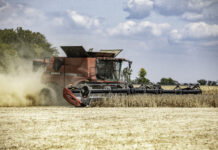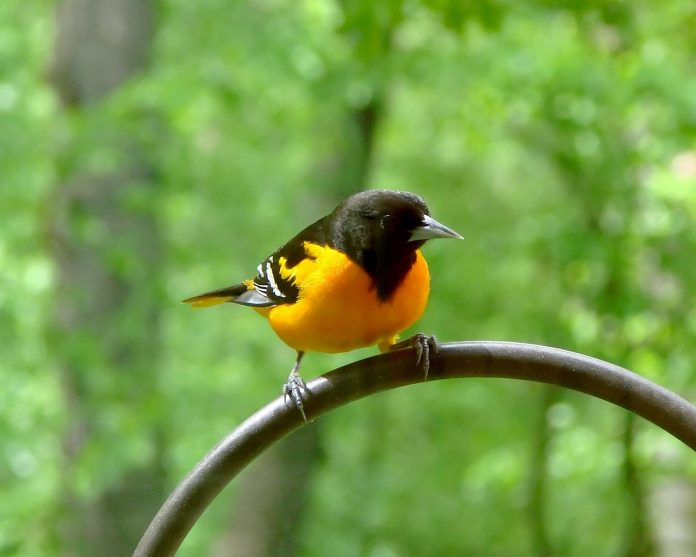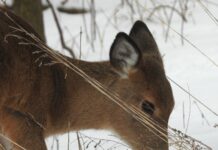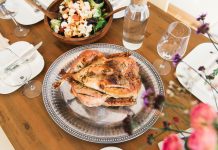Sometimes bird names can be confusing.
For example, not all blue birds are bluebirds. Indigo buntings and blue jays are blue birds, but they are not bluebirds like the beloved cavity-nesting eastern bluebird.
Similarly, not all blackbirds are black. Red-winged blackbirds and brightly colored orioles are members of the blackbird family (Icteridae).
Orioles
The stars of the blackbird family are the orioles, and two species have just returned to their breeding grounds.
Look for their deep basket-like nests in tall backyard elms and sycamores.
The orange, black, and white northern (formerly Baltimore) orioles eat fruit and nectar, as well as a variety of insects and spiders.
So do orchard orioles, which are a bit smaller and less conspicuous than their more gaudy kin.
Male orchard orioles have rich chestnut rumps and underparts; the rest of the bird is black. Females of both species are much duller olive-yellow.
Food
Both Baltimore and orchard orioles drink nectar, so don’t be surprised to see them on hummingbird feeders.
Orioles also eat hairy caterpillars, such as eastern tent caterpillars and gypsy moth caterpillars.
Most birds avoid hairy caterpillars because they’re irritating and difficult to swallow.
Orioles and a few other birds such as tanagers and cuckoos don’t let a few nasty hairs discourage them.
They hold hairy caterpillars in their bill and whack them against a branch until most of the hairs fall off. Then it’s down the hatch.
Orioles can also be attracted with live mealworms, sliced orange halves on platform feeders, and a spoonful of generic grape jelly in a small dish.
Catbirds and Carolina wrens also love grape jelly.
Red-winged black birds
One of the most common birds of wet meadows and marshes, red-winged blackbirds are hard to miss.
The males sport jet-black bodies and bright red shoulder patches. Females’ brown streaky bodies suggest a large sparrow.
Vocally, red-wings are equally distinct. Listen for the males’ loud, “Kong-ka-ree!”
Cowbirds
Finally, brown-headed cowbirds are common blackbirds found on farmland, forest edges, and at feeders.
Males have shiny black bodies with distinctly brown heads. Females are uniformly grayish brown.
Though less obvious than more colorful blackbird species, it is their breeding behavior that makes cowbirds shine.
Cowbirds are “brood parasites.” They do not build a nest of their own. Instead, they lay their eggs in the nests of other birds.
Parasite
These “host” birds incubate the cowbird eggs and raise the chicks, often to the detriment of their own.
Presumably, this peculiar behavior originated on the prairies where cowbirds lived in association with the huge herds of bison that once roamed the Great Plains.
The cowbirds ate insects kicked up by the bison as they grazed their way across the prairie.
The bison, however, did not stay in one place long enough for the cowbirds to build their own nest and raise a brood, so the cowbirds adopted the parasitic lifestyle.
Strategy
This strategy enables cowbirds to avoid most of the work associated with reproduction.
Building a nest, defending a territory, incubating eggs, and feeding young are time-consuming and energy-demanding chores.
Cowbirds avoid these responsibilities by parasitizing other birds’ nests.
Female cowbirds invest hours each morning watching the coming and goings of other birds to locate their nests.
Each morning female cowbirds lay one egg in a nest of another bird. Warblers, vireos, and sparrows are their most frequent victims.
Before laying the egg, the female cowbird sometimes removes one of the host’s eggs.
Eggs
A female lays one egg per day for five or six days. After a few days of rest, she repeats the process.
Over the course of a nesting season a single female cowbird may lay as many as 40 eggs.
After the eggs are laid, the cowbird has the advantage. Cowbird eggs hatch a day or so before the host eggs, and cowbird chicks grow faster than host chicks.
Because of this head start, cowbird chicks are bigger than host chicks and get most of the food the adults bring to the nest.
The foster parents feed the chicks that beg most vigorously, so often their own chicks starve.
I’ve only scratched the surface of blackbird biology, but it should be clear that these are common, widespread, and fascinating species.














Good article! I have two Catbirds who are eating the grape jelly ALL day long :). So fun to watch and I enjoy their “song” and meowing.